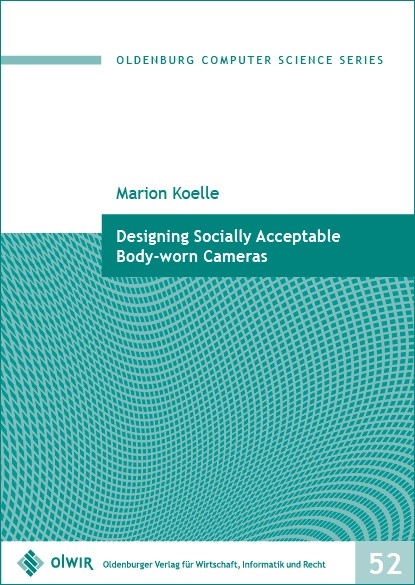
Designing Socially Acceptable Body-worn Cameras
Seiten
2020
OlWIR Verlag für Wirtschaft, Informatik und Recht
978-3-95599-070-1 (ISBN)
OlWIR Verlag für Wirtschaft, Informatik und Recht
978-3-95599-070-1 (ISBN)
Body-worn cameras, the focus of this thesis, promise a range of benefits, such as object recognition, tracking and visual navigation, but also personal expression and memory keeping. Simultaneously, not only taking pictures, but also not having one’s picture taken, can be understood as essential, modern-day right. Thus, bystander’s objections and concerns about privacy are serious and legitimate. In consequence, state-of-the-art body-worn camera devices lack social acceptability: they are not designed to address conflicts of interest between device user and their bystanders. This work targets social acceptability issues with body-worn cameras by identifying both the users’ and the bystanders’ needs, goals and values, and by addressing them through human-centered design (HCD).
To date, HCD only sparsely provides methods and best practices to attend to social acceptability issues. In particular, social acceptability issues are often considered only after deployment, which may lead to costly re-design of interfaces, or increase the stigmatization of users. Starting out from the example of body- worn cameras, my thesis challenges interface design to attend to social acceptability issues not after deployment, but during all phases of the HCD process. To this aim, this thesis makes three main contributions: First, it contributes a structured literature analyisis on how social acceptability and social acceptance are approached by state-of-the-art research in human-computer interaction. Most significantly, the analysis identifies an unbalanced distribution of study approaches and a lack of interlacing between empirical and artifact-creating approaches. Second, this thesis explores human-centered design (HCD) to create body-worn cameras that meet both the user’s and the bystander’s needs, goals, and values. Results show that bystanders’ knowledge about usage intentions has an effect on social acceptability, and that candid form factors can leverage this effect to improve social acceptability. Third, the work critically reflects on the presented HCD process and the employed methods and suggests a toolbox of applicable methods.
This work may serve as a reference for developers, engineers, designers and researchers with an interest in social acceptability and designing human-machine interfaces for social context.
To date, HCD only sparsely provides methods and best practices to attend to social acceptability issues. In particular, social acceptability issues are often considered only after deployment, which may lead to costly re-design of interfaces, or increase the stigmatization of users. Starting out from the example of body- worn cameras, my thesis challenges interface design to attend to social acceptability issues not after deployment, but during all phases of the HCD process. To this aim, this thesis makes three main contributions: First, it contributes a structured literature analyisis on how social acceptability and social acceptance are approached by state-of-the-art research in human-computer interaction. Most significantly, the analysis identifies an unbalanced distribution of study approaches and a lack of interlacing between empirical and artifact-creating approaches. Second, this thesis explores human-centered design (HCD) to create body-worn cameras that meet both the user’s and the bystander’s needs, goals, and values. Results show that bystanders’ knowledge about usage intentions has an effect on social acceptability, and that candid form factors can leverage this effect to improve social acceptability. Third, the work critically reflects on the presented HCD process and the employed methods and suggests a toolbox of applicable methods.
This work may serve as a reference for developers, engineers, designers and researchers with an interest in social acceptability and designing human-machine interfaces for social context.
| Erscheinungsdatum | 21.10.2020 |
|---|---|
| Reihe/Serie | Oldenburg Computer Science Series ; 52 |
| Verlagsort | Edewecht |
| Sprache | englisch |
| Maße | 147 x 210 mm |
| Gewicht | 385 g |
| Themenwelt | Mathematik / Informatik ► Informatik ► Grafik / Design |
| Mathematik / Informatik ► Informatik ► Weitere Themen | |
| Schlagworte | Bodycam • Body-worn Camera • Privacy Mediation |
| ISBN-10 | 3-95599-070-2 / 3955990702 |
| ISBN-13 | 978-3-95599-070-1 / 9783955990701 |
| Zustand | Neuware |
| Haben Sie eine Frage zum Produkt? |
Mehr entdecken
aus dem Bereich
aus dem Bereich
Schritt für Schritt zu Vektorkunst, Illustration und Screendesign
Buch | Hardcover (2023)
Rheinwerk (Verlag)
39,90 €
Fit für Studium und Ausbildung
Buch | Softcover (2022)
Rheinwerk (Verlag)
24,90 €
Die Kreativmaschine. Next Edition
Buch | Softcover (2024)
Verlag Hermann Schmidt
40,00 €


